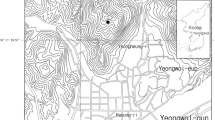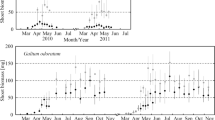Abstract
Fifteen relatively narrow stands of Typha angustifolia, including both stands bounded to open water and ridged boundary, were investigated in terms of the distributions of ramet density as well as the fraction of flowering ramets. The ramet density, fraction of flowering ramet and morphological characteristics of ramets were measured continuously from one side of the stand to the other, together with depth and the nutrient concentration of pore water. The rhizome biomass was also measured at the periphery and at the center of the stand. The results indicated that the shoot density declined gradually from the edge to the center, however, the fraction of the flowering ramets were significantly higher at the edge while it rapidly declined away from the edge. Statistical analyses indicate that the ramet density depends on either depth or nutrient level of the pore water; however, the distance from the edge was the most probable factor to reduce the fraction of the flowering ramets. The rhizome biomass was mostly larger at the periphery than at the center, likely because the accumulation of the horizontal rhizomes as extension was blocked by the boundary. High flowering fraction near the periphery was probably induced by the hormonal change caused by the blockage. However, a large fraction of ramets flowered simultaneously with large rhizome biomass at the periphery, likely because of the preferable light climates compared with inside the stand.




Similar content being viewed by others
References
Anita RN (1985) Heat transfer of rhyniophytic plant axes. Rev Palaeobot Palynol 116:109–122
Asaeda T, Hai DN, Manatunge J, Williams D, Roberts J (2005) Latitudinal characteristics of below- and above-ground biomass of Typha: a modelling approach. Ann Bot 96:299–312
Čížková H, Pechar L, Husák T, Kvĕt J, Václav B, Radová J, Edwards K (2001) Chemical characteristics of soils and pore waters of three wetland sites dominated by Phragmites australis: relation to vegetation composition and reed performance. Aquat Bot 69:235–249
Clesceri LS, Greenberg AE, Eaton AD (eds) (1998) Standard methods for the examination of water and wastewater, 20th edn. APHA-AWWA-WEF 4–99:4–146
Grace JB (1985) Juveniles vs. adult competitive abilities in plants: size-dependende in cattails (Typha). Ecology 66:1630–1638
Grace JB (1988) The effects of nutrient additions on mixtures of Typha latifolia L. and Typha domingensis. Pers Alomg a water-depth gradient. Aquat Bot 31:83–92
Grace JB (1989) Effects of water depth on Typha latifolia and Typha domingensis. Am J Bot 76:762–768
Grace JB, Wetzel RG (1981a) Effects of size and growth rate on vegetative reproduction in Typha. Oecologia 50:158–161
Grace J, Wetzel RG (1981b) Pheontypic and genotypic componenets of growth and reproduction in Typha latifolia: experimental studies in marshes of differeing successional maturity. Ecology 62:789–801
Grace JB, Wetzel R (1981c) Habitat partitioning and competitive displacement in cattails (Typha): experimental field studies of intensity of competition. Am Nat 118:463–474
Grace JB, Wetzel RG (1982) Variations in growth and reproduction within populations of two rhizomatous plant species: Typha latifolia and Typha angustifolia. Oecologia 53:258–263
Grace JB, Wetzel RG (1998) Long-term dynamics of Typha populations. Aquat Bot 61:137–146
Holler LC, Abrahamson WG (1977) Seed and vegetative reproduction in relation to density in Fragaria virginiana (Rosaceae). Am J Bot 64:1003–1007
Hotchkiss N, Dozier HL (1949) Taxonomy and distribution of N American cat-tails. Am Nat 41:237–254
Hydes DJ, Le Gall AC, Miller AEJ, Brockmann U, Raabe T, Holley S, Alvarez-Salgado X, Antia A, Balzer W, Chou L, Elskens M, Helder W, IJoint I, Orren M (2001) Supply and demand of nutrients and dissolved organic matter at and across the NW European shelf break in relation to hydrography and biogeochemical activity. Deep-Sea Res II 48:3023–3047
Kim C, Shin H, Choi HK (2003) A phenetic analysis of Typha in Korea and far east Russia. Aquat Bot 75:33–43
Krattinger K (1975) Genetic mobility in Typha. Aquat Bot 1:57–70
Karunaratne S, Asaeda T, Yutani K (2004) Age-specific seasonal storage dynamics of Phragmites australis rhizomes: a preliminary study. Wetland Ecol Manage 12:343–351
Miao SL, McCormick PV, Newman S, Rajagopalan S (2001) Interactive effects of seed availability, water depth, and phosphorus enrichment on cattail colonization in an Everglades wetland. Wetlands Ecol Manage 9:39–47
Nayar S, Miller D, Bryars S, Cheshire AC (2006) A simple, inexpensive and large volume pore water sampler for sandy and muddy substrates. Estuar Coast Shelf Sci 66:298–302
Newman S, Grace JB, Koebel JW (1996) Effects of nutrients and hydroperiod on Typha, Cladium, and Eleocharis: implication for everglades restoration. Ecol Appl 6:774–783
Ostendorp W (1995) Estimation of mechanical resistance of lakeside Phragmites stands. Aquat Bot 51:87–101
Ostendorp W (1999) Susceptibility of lakeside phragmites reeds to environmental stresses: examples from Lake Constance-Untersee (SW-Germany). Limnologica—Ecol Manage Inland Waters 29:21–27
Pezeshki SR, DeLaune RD, Kludze HK, Choi HS (1996) Photosynthetic and growth responses of cattail (Typha domingensis) and sawgrass (Cladium jamaicense) to soil redox conditions. Aquat Bot 54:25–35
Riis T, Sand-Jensen K, Larsen SE (2001). Plant distribution and abundance in relation to physical condition and location within Danish stream systems. Hydrobiologia 448:217–228
Sarena MS, Allison AS (2004) The potential for hybridization between Typha angustifolia and Typha latifolia in a constructed wetland. Aquat Bot 78:361–369
Steinbachova-Vojtiskova L, Tylova E, Soukup A, Novicka H, Votrubova O, Lipavska H, Cizkova H (2006) Influence of nutrient supply on growth, carbohydrate, and nitrogen metabolic relations in Typha angustifolia. Environ Exp Bot 57:246–257
Suomela J, Gran V, Helminen H, Lagus A, Lehtoranta J, Sipura J (2005) Effects of sediment and nutrient enrichment on water quality in the Archipelago Sea, northern Baltic: an enclosure experiment in shallow water. Estuar Coast Shelf Sci 65:337–350
Svengsouk LJ, Mitsch W (2001) Dynamics of mixuture of Typha latifolia and Schoenoplectus tabernaemontani in nutrient-enrichment wetland experiments. Am Midl Nat 145:309–324
Tornbjerg T, Bendix M, Brix H (1994) Internal gas transport in Typha latifolia L. and Typha angustifolia L. 2. Convective throughflow pathways and ecological significance. Aquat Bot 49:91–105
Ulrich KE, Burton TM (1988) An experimental comparison of the dry matter and nutrient distribution patterns of Typha latifolia L., Typha angustifolia L., Aparganium eurycarpum Engelm. and Phragmites australis (Cav.) Trin. ex Steudel. Aquat Bot 32:129–139
Weiner D, Fisher D, Moses EJ, Katz B, Meron G (2001) Operation experience of a solar- and wind-powered desalination demonstration plant. Desalination 137:7–13
Acknowledgements
We would like to thank Dr. Takeshi Fujino for his suggestion, Nguyen Thi Hai, Bakari J. Mnaya and other members of the Ecological Engineering Laboratory, Saitama University, for their assistance.
Author information
Authors and Affiliations
Corresponding author
Rights and permissions
About this article
Cite this article
Asaeda, T., Hung, L.Q. Internal heterogeneity of ramet and flower densities of Typha angustifolia near the boundary of the stand. Wetlands Ecol Manage 15, 155–164 (2007). https://doi.org/10.1007/s11273-006-9021-7
Received:
Accepted:
Published:
Issue Date:
DOI: https://doi.org/10.1007/s11273-006-9021-7




